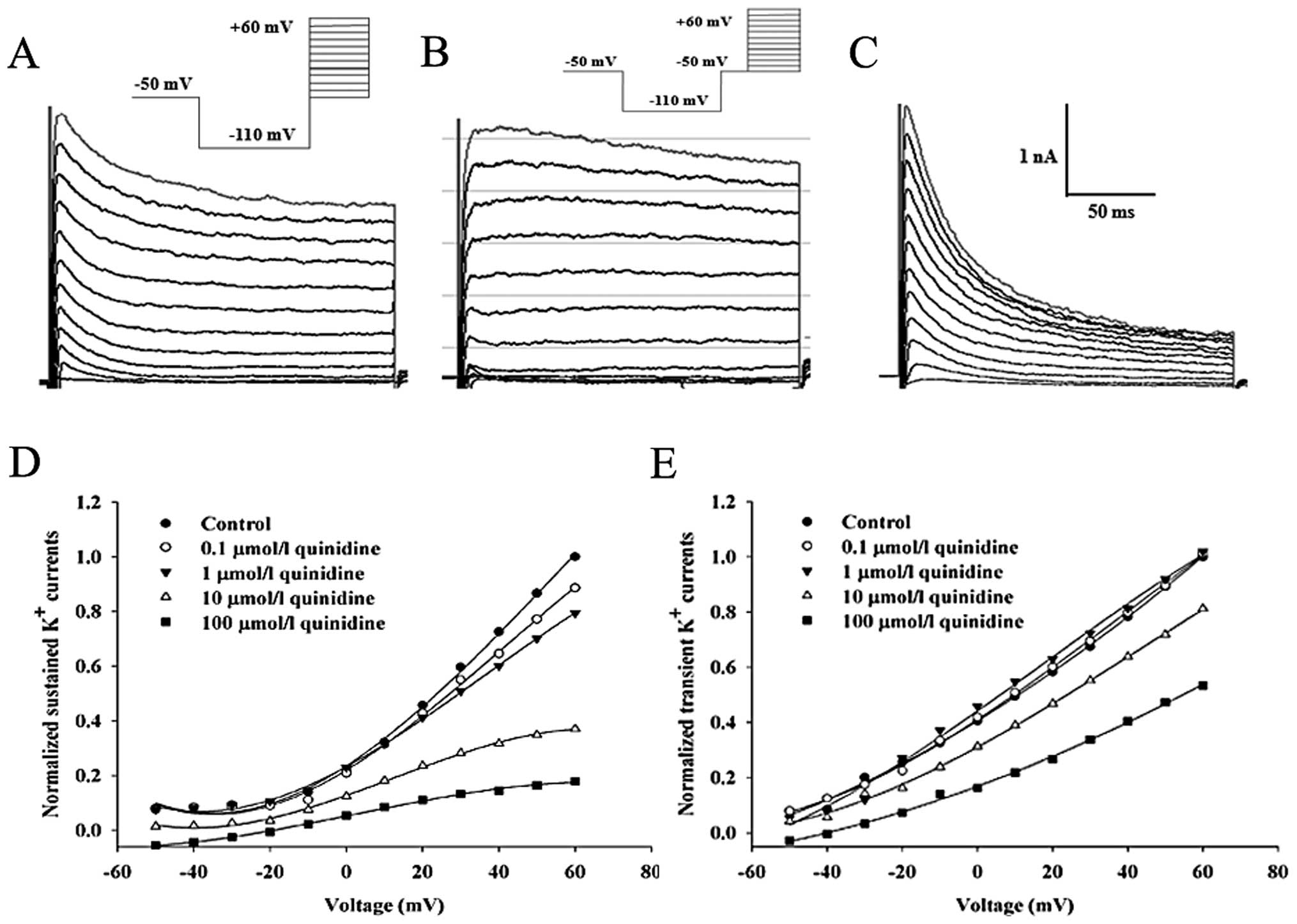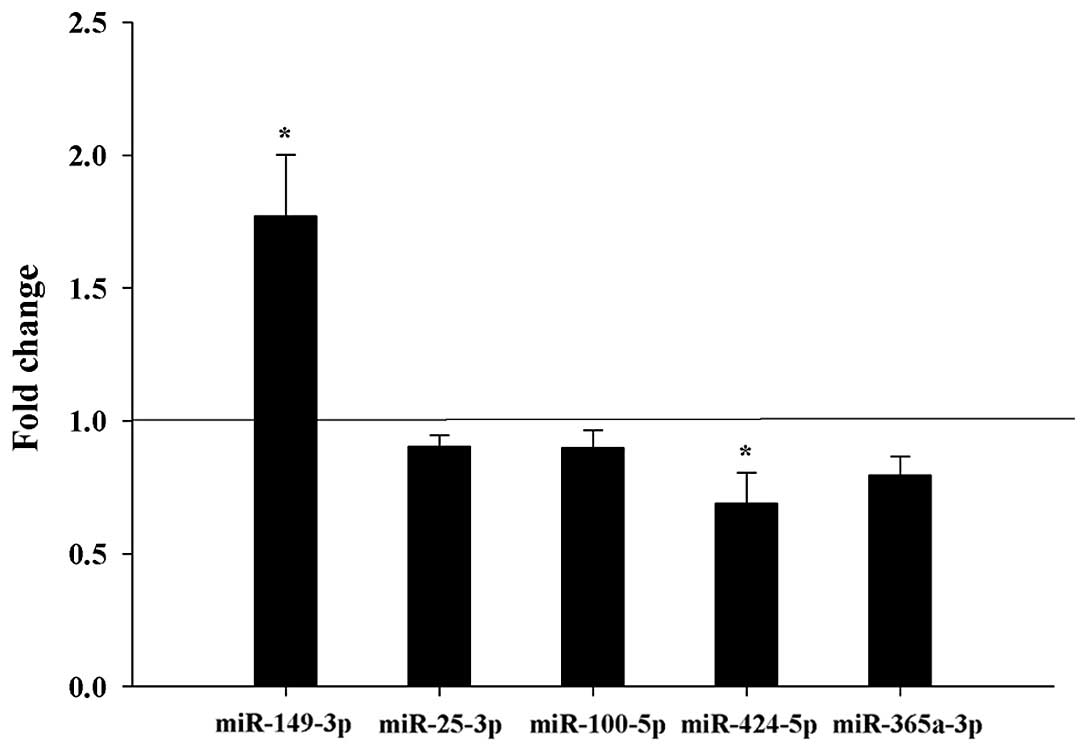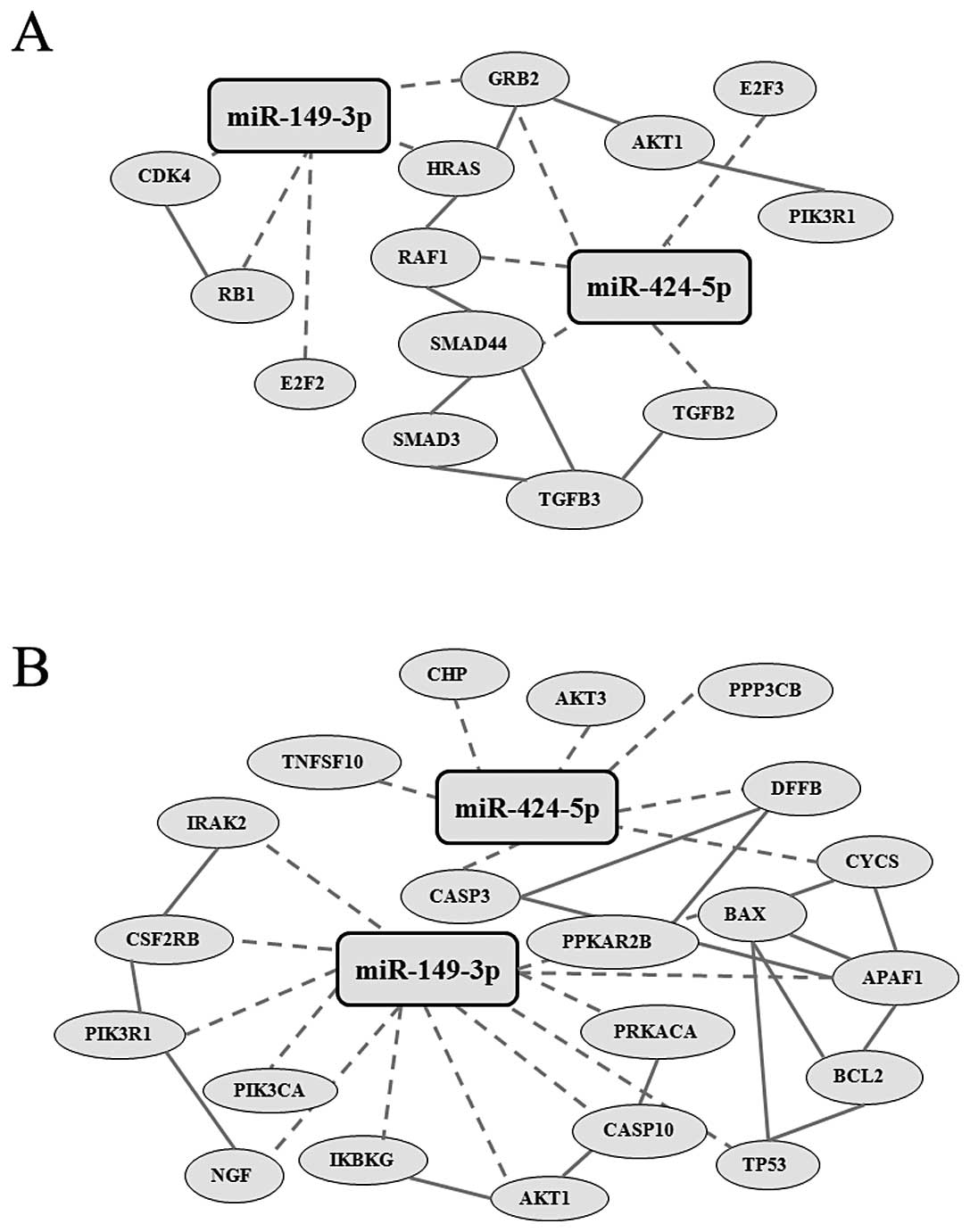|
1
|
Pardo LA: Voltage-gated potassium channels
in cell proliferation. Physiology (Bethesda). 19:285–292. 2004.
View Article : Google Scholar
|
|
2
|
Kunzelmann K: Ion channels and cancer. J
Membr Biol. 205:159–173. 2005. View Article : Google Scholar : PubMed/NCBI
|
|
3
|
Abdullaev IF, Rudkouskaya A, Mongin AA and
Kuo Y-H: Calcium-activated potassium channels BK and IK1 are
functionally expressed in human gliomas but do not regulate cell
proliferation. PLoS One. 5:e123042010. View Article : Google Scholar : PubMed/NCBI
|
|
4
|
Mu D, Chen L, Zhang X, See LH, Koch CM,
Yen C, Tong JJ, Spiegel L, Nguyen KC, Servoss A, Peng Y, Pei L,
Marks JR, Lowe S, Hoey T, Jan LY, McCombie WR, Wigler MH and Powers
S: Genomic amplification and oncogenic properties of the KCNK9
potassium channel gene. Cancer Cell. 3:297–302. 2003. View Article : Google Scholar : PubMed/NCBI
|
|
5
|
Huang L, Li B, Li W, Guo H and Zou F:
ATP-sensitive potassium channels control glioma cells proliferation
by regulating ERK activity. Carcinogenesis. 30:737–744. 2009.
View Article : Google Scholar : PubMed/NCBI
|
|
6
|
Fiske JL, Fomin VP, Brown ML, Duncan RL
and Sikes RA: Voltage-sensitive ion channels and cancer. Cancer
Metastasis Rev. 25:493–500. 2006. View Article : Google Scholar : PubMed/NCBI
|
|
7
|
Ru Q, Tian X, Wu YX, Wu RH, Pi MS and Li
CY: Voltage-gated and ATP-sensitive K+ channels are
associated with cell proliferation and tumorigenesis of human
glioma. Oncol Rep. 31:842–848. 2014.
|
|
8
|
Utermark T, Alekov A, Lerche H, Abramowski
V, Giovannini M and Hanemann CO: Quinidine impairs proliferation of
neurofibromatosis type 2-deficient human malignant mesothelioma
cells. Cancer. 97:1955–1962. 2003. View Article : Google Scholar : PubMed/NCBI
|
|
9
|
Weiger TM, Colombatto S, Kainz V,
Heidegger W, Grillo MA and Hermann A: Potassium channel blockers
quinidine and caesium halt cell proliferation in C6 glioma cells
via a polyamine-dependent mechanism. Biochem Soc Trans. 35:391–395.
2007. View Article : Google Scholar : PubMed/NCBI
|
|
10
|
Bushati N and Cohen SM: microRNA
functions. Annu Rev Cell Dev Biol. 23:175–205. 2007. View Article : Google Scholar : PubMed/NCBI
|
|
11
|
Visone R and Croce CM: MiRNAs and cancer.
Am J Pathol. 174:1131–1138. 2009. View Article : Google Scholar : PubMed/NCBI
|
|
12
|
Martin EC, Bratton MR, Zhu Y, Rhodes LV,
Tilghman SL, Collins-Burow BM and Burow ME: Insulin-like growth
factor-1 signaling regulates miRNA expression in MCF-7 breast
cancer cell line. PLoS One. 7:e490672012. View Article : Google Scholar : PubMed/NCBI
|
|
13
|
Jiang X, Zhang JT and Chan HC: Ion
channels/transporters as epigenetic regulators? - a microRNA
perspective. Sci China Life Sci. 55:753–760. 2012. View Article : Google Scholar : PubMed/NCBI
|
|
14
|
Bhattacharyya S, Balakathiresan NS,
Dalgard C, Gutti U, Armistead D, Jozwik C, Srivastava M, Pollard HB
and Biswas R: Elevated miR-155 promotes inflammation in cystic
fibrosis by driving hyperexpression of interleukin-8. J Biol Chem.
286:11604–11615. 2011. View Article : Google Scholar : PubMed/NCBI
|
|
15
|
Gao W, Lu X, Liu L, Xu J, Feng D and Shu
Y: MiRNA-21: a biomarker predictive for platinum-based adjuvant
chemotherapy response in patients with non-small cell lung cancer.
Cancer Biol Ther. 13:330–340. 2012. View Article : Google Scholar : PubMed/NCBI
|
|
16
|
Kumarswamy R, Volkmann I and Thum T:
Regulation and function of miRNA-21 in health and disease. RNA
Biol. 8:706–713. 2011. View Article : Google Scholar : PubMed/NCBI
|
|
17
|
Carrillo ED, Escobar Y, González G,
Hernández A, Galindo JM, García MC and Sánchez JA:
Posttranscriptional regulation of the β2-subunit of cardiac L-type
Ca2+ channels by MicroRNAs during long-term exposure to
isoproterenol in rats. J Cardiovasc Pharmacol. 58:470–478. 2011.
View Article : Google Scholar : PubMed/NCBI
|
|
18
|
Akamine T, Nishimura Y, Ito K, Uji Y and
Yamamoto T: Effects of haloperidol on K(+) currents in acutely
isolated rat retinal ganglion cells. Invest Ophthalmol Vis Sci.
43:1257–1261. 2002.PubMed/NCBI
|
|
19
|
Liu YW and Li CY: Inhibition of
N-methyl-D-aspartate-activated current by bis(7)-tacrine in HEK-293
cells expressing NR1/NR2A or NR1/NR2B receptors. J Huazhong Univ
Sci Technolog Med Sci. 32:793–797. 2012. View Article : Google Scholar : PubMed/NCBI
|
|
20
|
Bao Q and Shi Y: Apoptosome: a platform
for the activation of initiator caspases. Cell Death Differ.
14:56–65. 2007. View Article : Google Scholar
|
|
21
|
Fishman MC and Spector I: Potassium
current suppression by quinidine reveals additional calcium
currents in neuroblastoma cells. Proc Natl Acad Sci USA.
78:5245–5249. 1981. View Article : Google Scholar : PubMed/NCBI
|
|
22
|
Pan SJ, Zhan SK, Pei BG, Sun QF, Bian LG
and Sun BM: MicroRNA-149 inhibits proliferation and invasion of
glioma cells via blockade of AKT1 signaling. Int J Immunopathol
Pharmacol. 25:871–881. 2012.
|
|
23
|
Wu K, Hu G, He X, Zhou P, Li J, He B and
Sun W: MicroRNA-424-5p suppresses the expression of SOCS6 in
pancreatic cancer. Pathol Oncol Res. 19:739–748. 2013. View Article : Google Scholar : PubMed/NCBI
|
|
24
|
DeCoursey TE, Chandy KG, Gupta S and
Cahalan MD: Voltage-gated K+ channels in human T
lymphocytes: a role in mitogenesis? Nature. 307:465–468. 1984.
View Article : Google Scholar : PubMed/NCBI
|
|
25
|
Jang SH, Kang KS, Ryu PD and Lee SY: Kv1.3
voltage-gated K(+) channel subunit as a potential diagnostic marker
and therapeutic target for breast cancer. BMB Rep. 42:535–539.
2009. View Article : Google Scholar : PubMed/NCBI
|
|
26
|
Ru Q, Shang BY, Miao QF, Li L, Wu SY, Gao
RJ and Zhen YS: A cell penetrating peptide-integrated and
enediyne-energized fusion protein shows potent antitumor activity.
Eur J Pharm Sci. 47:781–789. 2012. View Article : Google Scholar : PubMed/NCBI
|
|
27
|
Preussat K, Beetz C, Schrey M, Kraft R,
Wölfl S, Kalff R and Patt S: Expression of voltage-gated potassium
channels Kv1.3 and Kv1.5 in human gliomas. Neurosci Lett.
346:33–36. 2003. View Article : Google Scholar : PubMed/NCBI
|
|
28
|
Mutlu A, Gyulkhandanyan AV, Freedman J and
Leytin V: Activation of caspases-9, -3 and -8 in human platelets
triggered by BH3-only mimetic ABT-737 and calcium ionophore A23187:
caspase-8 is activated via bypass of the death receptors. Br J
Haematol. 159:565–571. 2012.PubMed/NCBI
|
|
29
|
Le Guennec JY, Ouadid-Ahidouch H, Soriani
O, Besson P, Ahidouch A and Vandier C: Voltage-gated ion channels,
new targets in anti-cancer research. Recent Pat Anticancer Drug
Discov. 2:189–202. 2007. View Article : Google Scholar
|
|
30
|
Fraser SP, Grimes JA, Diss JK, Stewart D,
Dolly JO and Djamgoz MB: Predominant expression of Kv1.3
voltage-gated K+ channel subunit in rat prostate cancer
cell lines: electrophysiological, pharmacological and molecular
characterisation. Pflugers Arch. 446:559–571. 2003. View Article : Google Scholar : PubMed/NCBI
|
|
31
|
Ying Z, Li Y, Wu J, Zhu X, Yang Y, Tian H,
Li W, Hu B, Cheng SY and Li M: Loss of miR-204 expression enhances
glioma migration and stem cell-like phenotype. Cancer Res.
73:990–999. 2013. View Article : Google Scholar :
|
|
32
|
Gabriely G, Yi M, Narayan RS, Niers JM,
Wurdinger T, Imitola J, Ligon KL, Kesari S, Esau C, Stephens RM,
Tannous BA and Krichevsky AM: Human glioma growth is controlled by
microRNA-10b. Cancer Res. 71:3563–3572. 2011. View Article : Google Scholar : PubMed/NCBI
|
|
33
|
Wang F, Ma YL, Zhang P, Shen TY, Shi CZ,
Yang YZ, Moyer MP, Zhang HZ, Chen HQ, Liang Y and Qin HL: SP1
mediates the link between methylation of the tumour suppressor
miR-149 and outcome in colorectal cancer. J Pathol. 229:12–24.
2013. View Article : Google Scholar
|
|
34
|
Lin RJ, Lin YC and Yu AL:
miR-149* induces apoptosis by inhibiting Akt1 and E2F1
in human cancer cells. Mol Carcinog. 49:719–727. 2010.PubMed/NCBI
|
|
35
|
Li D, Chen P, Li XY, Zhang LY, Xiong W,
Zhou M, Xiao L, Zeng F, Li XL, Wu MH and Li GY: Grade-specific
expression profiles of miRNAs/mRNAs and docking study in human
grade I–III astrocytomas. OMICS. 15:673–682. 2011. View Article : Google Scholar : PubMed/NCBI
|
|
36
|
Park YT, Jeong JY, Lee MJ, Kim KI, Kim TH,
Kwon YD, Lee C, Kim OJ and An HJ: MicroRNAs overexpressed in
ovarian ALDH1-positive cells are associated with chemoresistance. J
Ovarian Res. 6:182013. View Article : Google Scholar : PubMed/NCBI
|
|
37
|
Sand M, Skrygan M, Georgas D, Sand D, Hahn
SA, Gambichler T, Altmeyer P and Bechara FG: Microarray analysis of
microRNA expression in cutaneous squamous cell carcinoma. J
Dermatol Sci. 68:119–126. 2012. View Article : Google Scholar : PubMed/NCBI
|













